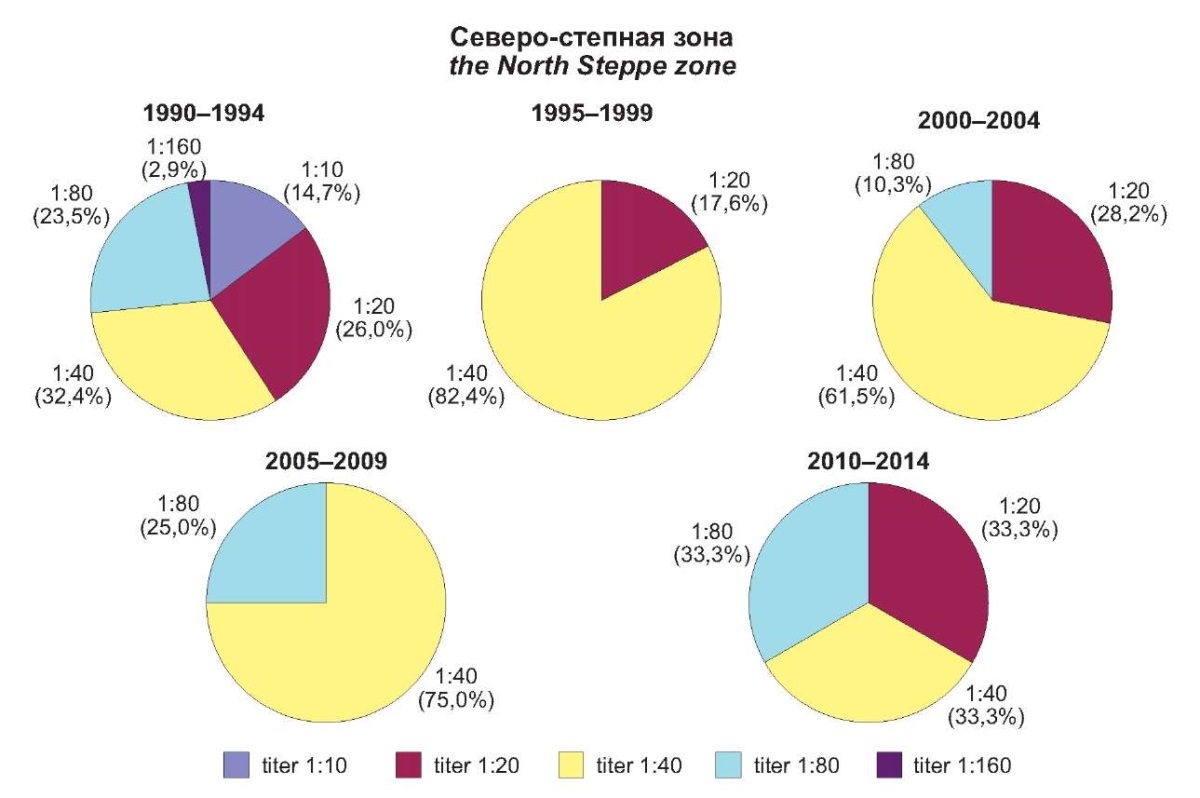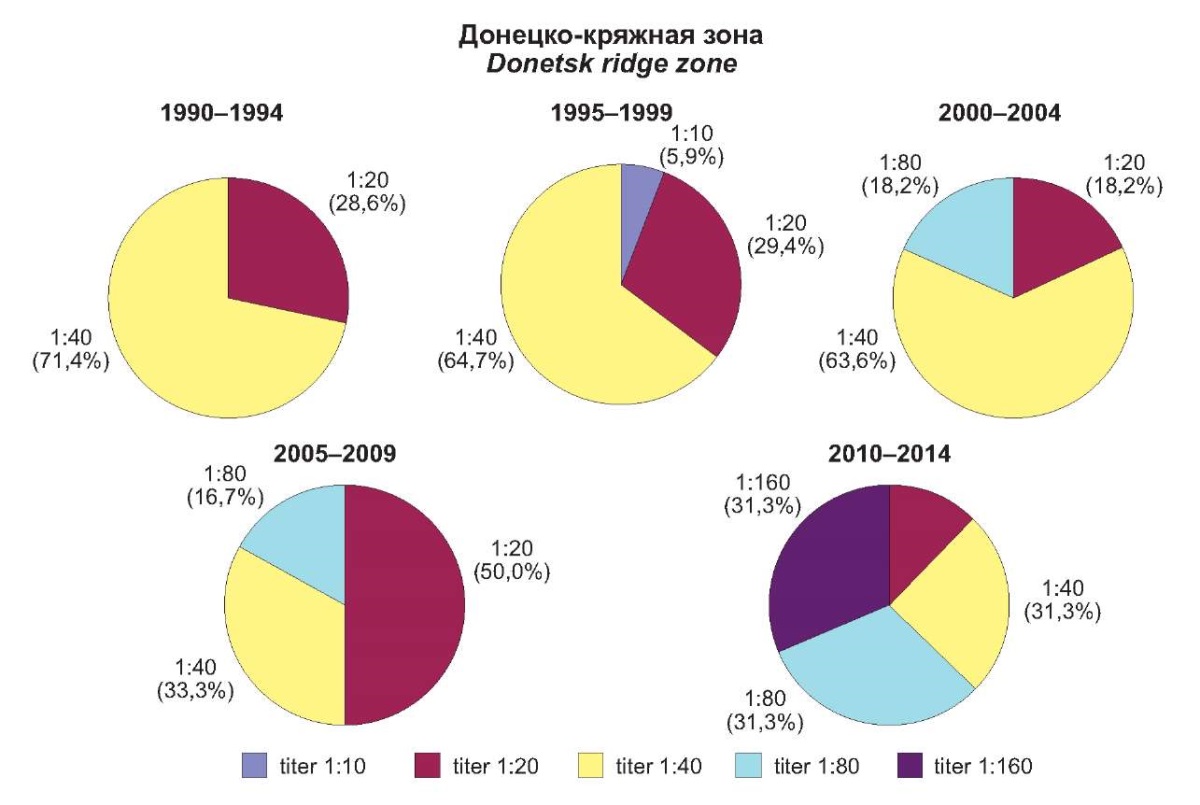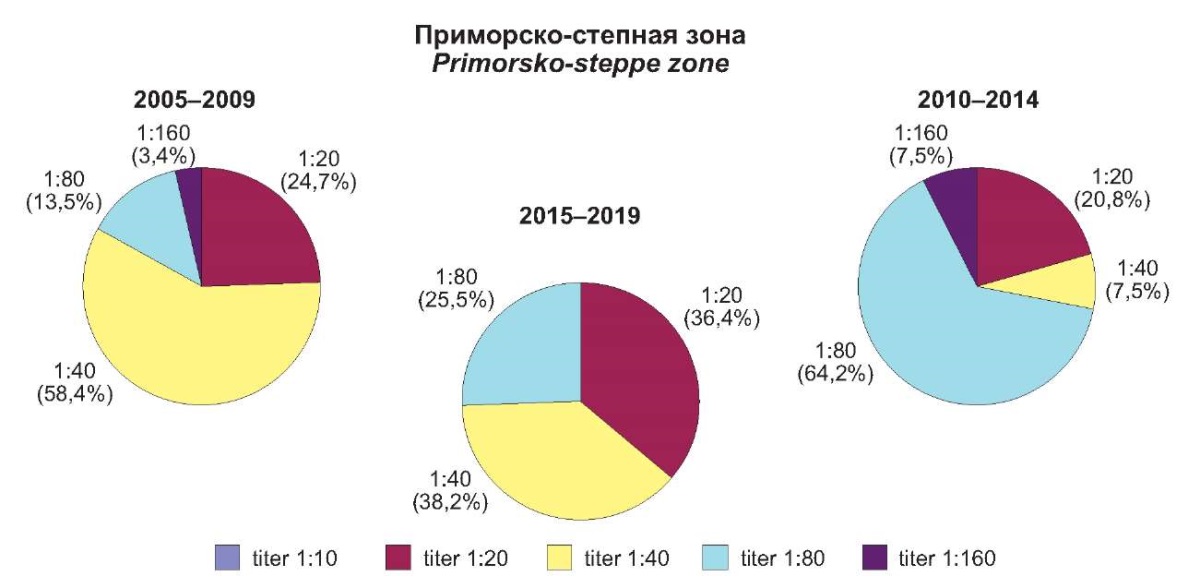Scroll to:
Episootological features of tularemia in the Donetsk region
https://doi.org/10.21886/2219-8075-2024-15-1-60-65
Abstract
Objective: to evaluate epizootic monitoring of tularemia in the Donetsk region.
Materials and methods: methods of retrospective, statistical, and comparative analysis were used. The sources of infection were investigated using serological and biological methods. The data of industry statistical reporting on form No. 40-annual of the department of especially dangerous infections of the Donetsk regional Sanitary and Epidemiological Station (since 2013 — SSESU, since 2015 — Republican Center for Sanitary and Epidemiological Surveillance of the State Sanitary and Epidemiological Service of the Ministry of Health of the DPR) were used. 20 "Maps of epizootological and epidemiological examination of the focus of zoonotic disease" (F.391/y) were studied.
Results: since 1987, the number of enzootic territories in the Donetsk region has increased annually: from 2 settlements in 1987 to 79 (in 4 cities and 16 districts) in 2023. With the beginning of active hostilities, the epidemic process of tularemia in Donbass has sharply intensified. Antibody titers (1:80 and 1:160) for tularemia were detected in environmental samples: in the North Steppe zone — 6.2%, Donetsk-Kryazhnaya — 10.4%, Primorsko-steppe — 15.8%. In the study of mouse-like rodents, 6 cultures of Francisella tularensis holarctica biovar II era R were isolated, resistance of the strain to ampicillin, cefotaxime, erythromycin, clindamycin, polymyxin was established; sensitivity to gentamicin, fluoroquinolones, rifampicin, doxycycline, levomycetin.
Conclusions: the activation of epizootic processes of tularemia in the DPR is associated with the conduct of hostilities. High titers of antibodies to tularemia in environmental samples are noted in the south of the Donetsk region.
For citations:
Skripka L.V. Episootological features of tularemia in the Donetsk region. Medical Herald of the South of Russia. 2024;15(1):60-65. (In Russ.) https://doi.org/10.21886/2219-8075-2024-15-1-60-65
Introduction
Tularemia is an acute zoonotic transmissible natural focal infection caused by the bacterium Francisella tularensis. For humans, more than 80 animal species can be the source of tularemia infection. The largest number of morbid events occurs due to infection from rodents including water rats, hares, muskrats, voles, hamsters, and mice. Livestock, including sheep, cows, horses, and pigs, can also be involved in the epizootic process. In the spreading of infection among animals, the leading role belongs to ticks [1], which transmit the pathogen by the transovarial path through mosquitoes and horseflies. Besides, transmission of F. tularensis from birds to humans has been reported in the scientific literature [2]. In recent years, a number of new species, living in seawater, in particular, different species of fish and shellfish, as well as other biological material, have been identified as infection carriers [3]. Infection of humans from animals occurs in various ways including transmissible, fecal-oral (water, food), aspirating (air-dust) paths, and household contacts. It is noteworthy that a sick person is not dangerous to others.
Natural foci of tularemia are widespread in different territories and pose a constant threat to human health [4–6]. According to data reported by certain researchers, the incidence of tularemia increases during or after armed conflicts due to the deterioration of living conditions, lack of guarantees of food safety, decreased levels of personal hygiene, and the inability to carry out preventive and anti-epidemic measures [7]. In connection with the conduction of warfare and the increase in the incidence of tularemia over recent years, it was of interest to investigate the features of the tularemia epizootic in the Donetsk Region, which determined the relevancy of this study.
The purpose of the study was to assess the state of epizootic monitoring of tularemia in the Donetsk People's Republic.
Materials and methods
Methods of retrospective, statistical, and comparative analysis were used for data processing. The examination of infection sources was carried out using serological and biological methods. In particular, antibody titers to tularemia in pellets of birds of prey were detected with the reaction of indirect hemagglutination. Using a biological method, a culture of the pathogen was isolated, and its properties were examined. In addition, the materials of data from sectorial statistical reporting in form No. 40-annual of the Department of Particularly Dangerous Infections of the Donetsk Regional Sanitary and Epidemiological Station (in 2013, renamed in the State Sanitary and Epidemiological Service of Ukraine; in 2015, renamed in the Republican Center for Sanitary and Epidemiological Surveillance of the State Sanitary and Epidemiological Service of the Ministry of Health of the DPR). To create a data bank, 20 “Cards of epizootological and epidemiological survey of the focus of zoonotic disease” (f. 391/u) were examined.
Results
The Donbass is an endemic area for tularemia with pronounced epizootic and epidemic potentials. The epidemic process of tularemia in the Donbass sharply intensified with the beginning of active warfare. From 2008 to 2015, no case of tularemia in humans was registered. However, in 2016, an outbreak of tularemia was revealed in the Novoazovsky District, affecting 9 people. Moreover, for 9 months in 2023, 48 cases of tularemia in humans have already been registered. The incidence rate was 1.7 per 100,000 population, which is 4.9 times higher compared to the indicator in 2022 when it was equal to 0.35 per 100,000 population. These data attest to a sharp deterioration in the epidemiological situation with a pronounced tendency toward an increase in the incidence of tularemia in the DPR over the past 6 years [8]. This process was also facilitated by the failure to carry out deratization in natural habitats. Preventive deratization work was carried out only at objects of epidemiological risk.
According to archival data, against the background of changes in the structure of biocenoses, which contributed to the mass reproduction of mouse-like rodents and their migration to populated areas, in the post-war period (1946 and 1949) in the Donetsk Region, activation of the tularemia epizootic was notable, which was accompanied by epidemic complications.
For several decades, the quiet situation with the registration of tularemia incidence was associated with the vaccination of the population living and working in areas enzootic for tularemia. However, since 1987, in the Donetsk Region, experts again began to record sluggish epidemic and epizootic processes of tularemia with their periodic activation.
In some years, namely, 1993, 2001, 2002, and 2004, the number of certain animal reservoirs of infection reached a high level. In addition, the number of enzootic territories increased annually from 2 settlements in 1987 to 79 ones, including 4 towns and 16 districts, in 2023. In 2014, the proportion of administrative territories affected by tularemia in the region was already more than 30%.
In order to monitor the circulation of the tularemia pathogen in environmental objects, more than 28,000 specimens of mouse-like rodents, 36,458 specimens of ixodid ticks, 6,123 pellets of birds of prey, 925 hares, and 943 water samples from natural reservoirs were collected and examined for the period from 1993 to 2023. Positive tests of examined serological samples from mouse-like rodents (0.8%), pellets (4.5%), and hares (3.9%) indicate the constant circulation of the tularemia pathogen in natural foci [9].
An intensification of epizootic processes for tularemia in the DPR has been noted since 2015 against the background of an increase in the number of mouse-like rodents and ixodid ticks. This is confirmed by the results of laboratory monitoring of the circulation of the pathogen in environmental objects. The relative share of detecting the tularemia antigen in the examined pellets of birds of prey was 4.2% in 2014, 18.0% in 2015, and 20.7% in 2016. In the Novoazovsky District, the rate was 22% in 2016. The landscape features of the territories in the Novoazovsky District provide favorable conditions for the existence of small mammals, which are the main reservoir of the causative agent of natural focal infections.
In 2016, in addition to the Novoazovsky District, natural foci of tularemia demonstrated their activity in the Telmanovsky District. In particular, the tularemia antigens in environmental objects were revealed in more than 10% of the examined samples.
Based on the results of the long-term monitoring of tularemia in 2017, an active focus of tularemia was registered in the Yasinovatsky District, namely, in the Yakovlevka village. Here, a case of the disease among people was recorded. The territory of the Yasinovatsky District has been enzootic for tularemia since 2004 in virtue of a positive sampling of the parenchymal organs of a brown hare trapped in the hunting grounds of the Netailovo village. In 2015, two of six specimens of the common vole, trapped in the natural habitat of the Yasinovatsky District on the territory adjacent to the Yakovlevka village, had antibodies to tularemia with a titer of 1:20. Nevertheless, currently, the ongoing active warfare on this territory prevents monitoring of the external environment and anti-epidemic measures in full.
Cultures of the causative agent of tularemia were not isolated during the investigations of environmental objects in the Donetsk Region for the period from 1993 to 2015. In November 2016, the culture of Francisella tularensis, subspecies holarctica, biovar II ery R (erythromycin-resistant) was isolated from house mice, trapped for epidemic reasons in the Bezymennoe village of the Novoazovsky District upon exploring mouse-like rodents. In January 2017, 4 cultures of tularemia were isolated from house mice in 4 settlements of the Novoazovsky District upon exploring mouse-like rodents trapped for epidemic reasons. In 2023, cultures of the pathogen were isolated from rodents trapped in populated areas of the Telmanovsky District, as well as from water samples of the Gruzskaya Elanchik River, which was for the first time. The resistance of the strain to ampicillin, cefotaxime, erythromycin, clindamycin, and polymyxin, and the sensitivity of the strains to gentamicin, fluoroquinolones, rifampicin, doxycycline, and chloramphenicol were established during the culture sample examination.
The main species involved in the epizootic process of tularemia in the Donetsk Region are the common vole, house mouse, and other species of small mammals. In recent years, a constant increase in the antibody titers to F. tularensis has been revealed in rodents captured in natural foci of tularemia [10]. This may be stipulated by an increase in the rodent population, increased circulation of F. tularensis, and failure to conduct agricultural activities due to military operations. Besides, the identified fluctuations can, presumably, be explained by changing climatic conditions in recent years [11].
Fig. 1 indicates that in the Northern-Steppe zone of the Donetsk Region, the lowest epizootic activity was observed over the period of 2010–2014 (rate of 2.5%), and the highest one was noted over the period of 1990–1994 (rate of 12.2%). Concurrently, cases of tularemia over the period of 2010–2014 were not registered. Over periods, when the proportion of positive samplings ranged from 5% to 12.2%, experts revealed 2–3 cases.

Figure 1. The structure of positive results
of environmental research in the North Steppe zone.
Рисунок 1. Структура положительных результатов
исследования внешней среды в Северо-степной зоне.
An increase in the titer of antibodies (1:80 and 1:160) to tularemia detected in samples from the external environment was revealed in the south of the Donetsk Region. This trend was also found in serological specimens of pellets of birds of prey and rodents (in aggregate) in the Northern-Steppe zone (6.2%), as well as in Donetsk-Ridge (10.4%) and Coastal-Steppe zones (15.8%). Meanwhile, in the pellets of birds of prey from the Northern-Steppe zone, the proportion of positive samplings fluctuated within 12%, the rate was 15–36.4% in samples from the Donetsk-Ridge zone, and it was 11–25% in samples from the Coastal-Steppe zone. The proportion of positive samples among mouse-like rodents was 5–12% in the Northern-Steppe zone, 10–13% in the Donetsk-Ridge zone, and 14–32% in the Coastal-Steppe zone.
Fig. 2 indicates that in the Donetsk-Ridge zone, the lowest epizootic activity was observed in the period from 2015 to 2019 (5.8%), and the highest activity was in the period from 1990 to 1994 (43.8%). Notably, isolated cases of tularemia were recorded during periods with a proportion of positive samplings from 5.8% to 13.1%.

Figure 2. The structure of the positive results of the study
of the external environment in the Donetsk ridge zone.
Рисунок 2. Структура положительных результатов
исследования внешней среды в Донецко-кряжной зоне.
In general, during the examined periods, in these two zones, a pronounced tendency toward a decrease in the rate of infestation of rodents was evident.
. In the Coastal-Steppe zone, the lowest proportion of positive samples was 10.7% over the 2005–2009 period and the maximum one (23.8%) over the 2015–2019 period. In the latter period, for the first time during the past 30 years, the maximum number of cases was registered and amounted to 13.
In this zone, there was a pronounced negative trend toward an increase in the rate of rodent infestation (Fig. 3).

Figure 3. The structure of the positive results
of environmental research in the Primorsko-steppe zone.
Рисунок 3. Структура положительных результатов
исследования внешней среды в Приморско-степной зоне.
Discussion
Annual epizootological monitoring revealed an uneven distribution of positive samples for the marker of F. tularensis upon examining the main sources of tularemia over the Donetsk Region. The analysis included territories with serological indicators of samples from the external environment not lower than 1:20. According to information provided annually by the veterinary service, no case of tularemia was registered among animals.
The proportion of positive samplings from the external environment above the long-term average level was revealed in the Telmanovsky, Novoazovsky, and Amvrosievsky districts with rates from 30% to 50%. Activation of epizootic processes was mainly observed in the western and southwestern parts of the Donetsk Region. Registration of cases of tularemia and positive tests upon epizootological monitoring attest to the constant activity of natural foci of tularemia in the Donetsk Region.
Conclusions
The intensification of epizootic processes of tularemia in the DPR is associated with conducting warfare. High titers of antibodies to tularemia in environmental samples were found in the southern part of the Donetsk Region. Despite the possibility of improving the epidemic situation through specific prevention activity, the results obtained indicate that for drawing up an epidemiological forecast and working out a plan of anti-epidemic measures, comprehensive epizootological monitoring should be arranged [12–14].
References
1. Danchinova G.A., Khasnatinov M.A., Zlobin V.I., Kozlova I.V., Verkhozina M.M., et al. Ixodid ticks in Southern part of Eastern Siberia and Mongolia and their spontaneous infectiveness by infectious agents. Bulletin of Siberian Medicine. 2006;5:137-143. (In Russ.) https://doi.org/10.20538/1682-0363-2006--137-143
2. Mailles A, Vaillant V. 10 years of surveillance of human tularaemia in France. Euro Surveill. 2014;19(45):20956. https://doi.org/10.2807/1560-7917.es2014.19.45.20956
3. Janse I, van der Plaats RQJ, de Roda Husman AM, van Passel MWJ. Environmental Surveillance of Zoonotic Francisella tularensis in the Netherlands. Front Cell Infect Microbiol. 2018;8:140. https://doi.org/10.3389/fcimb.2018.00140
4. Kudryavtseva T.Y., Mokrievich A.N. Tularemia in the world. Russian Journal of Infection and Immunity.2020;11(2):249-264. https://doi.org/10.15789/2220-7619-TTW-1380
5. Faber M, Heuner K, Jacob D, Grunow R. Tularemia in Germany-A Re-emerging Zoonosis. Front Cell Infect Microbiol. 2018;8:40. https://doi.org/10.3389/fcimb.2018.00040
6. Kudryavtseva T.Yu., Popov V.P., Mokrievich A.N., Mazepa A.V., Okunev L.P., et al. Epidemiological and epizootiological analysis of the situation on tularemia in the Russian Federation in 2016 and forecast for 2017. Problems of Particularly Dangerous Infections. 2017;(2):13-18. (In Russ.) https://doi.org/10.21055/0370-1069-2017-2-13-18
7. Rusev I.T., Zakusilo V.N. Tularaemia epidemic outbreaks and epizootics as a consequence of the aircraft bombing in Kosovo. Visnyk of Dnipropetrovsk University. Biology. Medicine. 2012;2(3):71–80. (In Russ.)
8. Romanenko T.A., Skrypka L.V. The analysis of the incidence of tularemia in the population of the Donetsk region. University Clinic. 2021;4(41):100-107. (In Russ.) https://doi.org/10.26435/uc.v0i4(41).750
9. Mikhaylova T.V., Demidova T.N., Kormilitsyna M.I., Kvasov D.A., Kozorezov A.V., Trankvilevsky D.B. Epizootic Activity and Epidemic Manifestation of Natural Fod of Tularemia in Voronezh Region. Epidemiology and Vaccinal Prevention. 2017;16(1):16-21. (In Russ.) https://doi.org/10.31631/2073-3046-2017-16-1-16-21
10. Senichkina A.M., Osina N.A., Zaitsev A.A., Usol'tseva N.M., Usmanova S.M. Verification of new gene-diagnostic preparations in the context of epizootiological monitoring over tularemia agent in the territory of the Russian Federation. Public health and life environment - PH&LE. 2015;(6):43-46. (In Russ.) eLIBRARY ID: 23867524 EDN: UCHPWX
11. Kulikalova E.S., Perevalova M.A., Mazepa A.V., Syngeeva A.K., Balakhonov S.V., Kholin A.V. Tularemia in Siberia and Far East in 2005–2016. Infectious Diseases: News, Opinions, Training. 2018;7(2):115–21. (In Russ.) https://doi.org/10.24411/2305-3496-2018-12014
12. Origgi FC, König B, Lindholm AK, Mayor D, Pilo P. Tularemia among free-ranging mice without infection of exposed humans, Switzerland, 2012. Emerg Infect Dis. 2015;21(1):133-135. https://doi.org/10.3201/eid2101.140906
13. Arutyunov Y.I., Mishan'kin B.N., Pichurina N.L., Prospects for the study of natural foci of tularemia in the South Federal District. Epidemiology and Infectious Diseases. 2011;16(1):51-
14. (In Russ.) https://doi.org/10.17816/EID40589
15. Evstegneeva V.A., Chestnova T.V., Smolyaninova O.L. On neural network modeling and prediction of epizootics of tularemia in the Tula region. Bulletin of New Medical Technologies. 2014;(1):9. (In Russ.) https://doi.org/10.12737/7240
About the Author
L. V. SkripkaRussian Federation
Liliya V. Skrypka, Deputy Chief Physician for Anti-epidemic Issues
Donetsk
Competing Interests:
Автор заявляет об отсутствии конфликта интересов.
Review
For citations:
Skripka L.V. Episootological features of tularemia in the Donetsk region. Medical Herald of the South of Russia. 2024;15(1):60-65. (In Russ.) https://doi.org/10.21886/2219-8075-2024-15-1-60-65







































